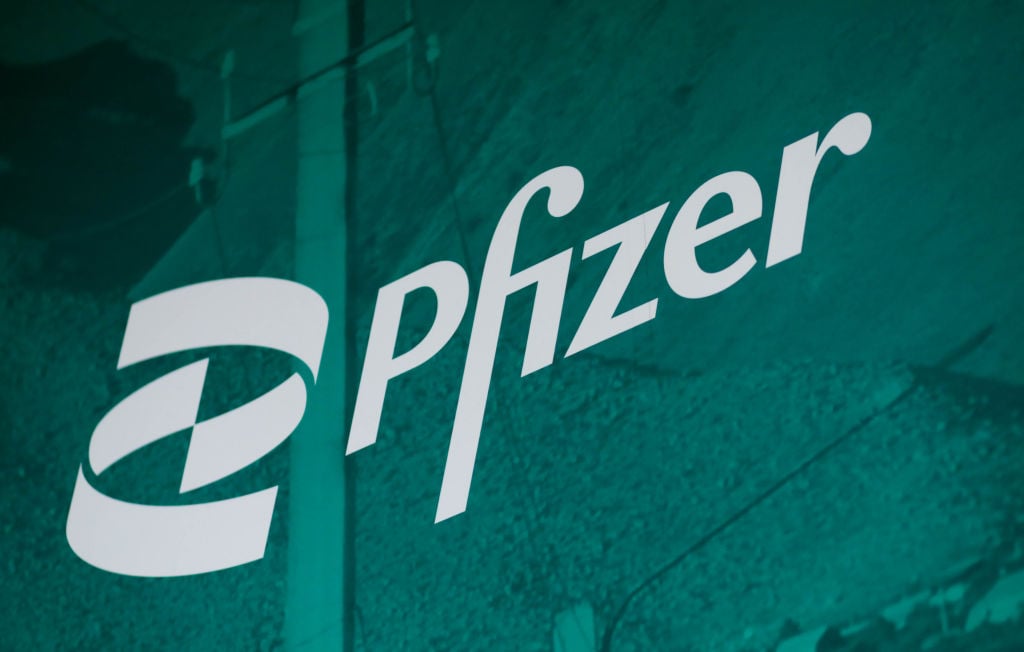
Image source: Pfizer.
Pharmaceutical juggernaut Pfizer (PFE +0.73%) dazzled Wall Street once again by reporting better-than-expected third-quarter earnings results before the opening bell on Wednesday.
Pfizer's Q3, by the numbers
For the quarter, Pfizer delivered $12.09 billion in revenue, a 2% year-over-year decline, while its reported net income dropped 20% to $2.13 billion from $2.67 billion. Pfizer's EPS dropped a similar 19% to $0.34 from $0.42.
However, these headline numbers include the negative effect of currency movements, as well as the acquisition costs associated with buying Hospira. If we exclude the $1.1 billion in adverse currency effects and other non-recurring expenses, Pfizer's apples-to-apples operations actually grew revenue by 6% on a year-over-year basis -- its fourth straight quarter of adjusted operational growth. Profit per share on an adjusted basis also rose by 5% to $0.60 from $0.57. Wall Street had anticipated just $11.49 billion in total revenue and a mere $0.51 in EPS.
Additionally, Pfizer boosted its full-year adjusted EPS guidance to a range of $2.16 to $2.20. For reference, Pfizer lifted its guidance in early September to a range of $2.04 to $2.10 in adjusted EPS. The recent surge in profit expectations for the full year likely has to do with the completion of the Hospira buyout and the official recognition of revenue and profits from its purchase.
What's working well
A lot went right for Pfizer in the latest quarter, as evidenced by its substantial profit beat and full-year guidance boost. However, what's most notable is the continued strength in its recently approved breast cancer drug, Ibrance.

Image source: Pfizer.
If you recall, Ibrance was approved in early February by the Food and Drug Administration after nearly doubling the progression-free survival in metastatic breast cancer patients who are estrogen-positive and HER2-negative. The doubling in PFS over the placebo group was extremely encouraging and lent to the idea that Ibrance would become one of the motors that would help drive Pfizer out of its multiyear revenue decline. After two full quarters on pharmacy shelves (and a partial quarter), Ibrance's uptake looks promising. Sales leaped from $38 million in its partial first quarter to $140 million in Q2, and then jumped once more to $230 million in Q3 on a global basis. On an extrapolated basis, it's likely that Ibrance will become a blockbuster drug (i.e., one that generates $1 billion or more in annual sales) by 2016. With the potential for label expansion, Ibrance looks poised to challenge Wall Street's peak annual sales targets of $3 billion-$5 billion.
Pfizer's global oncology division as a whole deserves a nod, too. Ibrance was a substantial reason why the division's sales rose by 54% on an operational basis to $786 million, though operational increases of 18%, 13%, and 10% from Xalkori, Inlyta, and Sutent, respectively, also packed some punch.
Vaccines were also insanely strong for Pfizer. Led by Pfizer's Prevnar family of vaccines -- which are designed to help prevent pneumonia in infants, young children, and the elderly -- global vaccine revenue surged 50% on an operational basis to $1.63 billion. Through the first nine months of 2015, global vaccine sales were up 51% operationally. Pfizer has commented in the past that this sales surge in vaccines is expected to slow considerably in 2016, but the long-term outlook for the Prevnar family is nonetheless bright.
What's not up to par
It's no huge surprise, but if we're going to nitpick Pfizer's earnings report, its global established products (GEP) segment -- which is comprised of mature drugs that are nearing the end of their patent protection period, or brand-name drugs that have come off patent -- performed poorly once again.

Image source: U.S. Food and Drug Administration.
On an operational basis, Pfizer's GEP sales fell by 13% to $4.89 billion. Anti-inflammatory Celebrex, once a blockbuster drug, did the most damage with a year-over-year sales decline of 69% to $212 million, although bacterial infection drug Zyvox wasn't much better with a 43% operational decline to $165 million. Lipitor continues to slowly fade away, with operational sales declining 1%, including a 1% decline in overseas markets, where it had been gaining modestly in previous quarters.
Xeljanz's complete response letter from the FDA concerning its attempt to expand its label to moderate-to-severe plaque psoriasis was another downer. Originally Wall Street had projected that Xeljanz could bring in as much as $3 billion per year in peak sales, but a less-than-stellar safety profile could leave Xeljanz struggling to break $1 billion in annual sales.
This comment is a bit worrisome
We'll dive more deeply into the minute details of Pfizer's conference call in the coming week. However, after a quick read-through of the commentary from Pfizer's management team, one point made by CEO Ian Read has me somewhat concerned.
Based on the S&P Capital IQ transcript of the early-morning conference call, Ian Read said while discussing Pfizer's cancer immunotherapy product avelumab: "If successful, the first potential commercial launch of avelumab is anticipated in 2017, and our goal is to have at least one or more additional launches each year through 2022."
The commentary on avelumab's potential approval is great news for Pfizer. Immunotherapies are the next big thing in cancer treatment, and there's a broad array of solid tumors, and perhaps even blood cancers, that this new class of drug may effectively treat. Even with Pfizer entering the market years after some of its peers, avelumab should still have blockbuster potential.

Image source: Pfizer.
My concern with the above statement is that Pfizer has a massive pipeline, and one or two launches a year seems disappointing when smaller biotech blue-chips are launching products at a faster pace. I believe Read's commentary all but ensures that Pfizer will have no choice but to keep buying other companies in order to grow.
Growth by M&A isn't necessarily a bad thing, but it exposes Pfizer to the risk of overpaying for another company's product portfolio or pipeline. Pfizer's 2009 merger with Wyeth was supposed to be a game-changer that put it back on track for sustainable growth. In reality, the Pfizer-Wyeth deal did little to bolster shareholder confidence; Pfizer's dividend payout was halved, and both R&D and productivity sank. If investors can't rely on organic growth to drive Pfizer's top and bottom lines, they may want to reduce the premium they'd consider paying for its stock.
Is Pfizer a buy?
The big question of the day following the company's earnings report is whether or not Pfizer remains worth buying now.
I believe that if your intention is to buy and hold for 10 years or more, then you'll likely wind up profiting thanks to Pfizer's healthy cash flow. However, its reliance on M&A for growth, coupled with the uncertainties of what it'll do with its GEP portfolio, leads me to believe that you could likely find better investment opportunities among drug developers.






